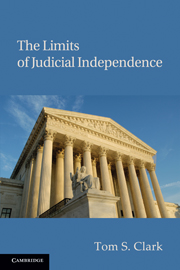Book contents
- Frontmatter
- Contents
- List of Tables
- List of Figures
- Acknowledgments
- 1 Introduction
- 2 A Political History of Court-Curbing
- 3 Conditional Self-Restraint
- 4 Court-Curbing and the Electoral Connection
- 5 Public Support and Judicial Review
- 6 Ideological Implications of Court-Curbing
- 7 The Limits of Judicial Independence
- Appendix A Elite Interview Methodology
- Appendix B Court-Curbing Bills, 1877–2008
- Bibliography
- Index
6 - Ideological Implications of Court-Curbing
Published online by Cambridge University Press: 05 August 2012
- Frontmatter
- Contents
- List of Tables
- List of Figures
- Acknowledgments
- 1 Introduction
- 2 A Political History of Court-Curbing
- 3 Conditional Self-Restraint
- 4 Court-Curbing and the Electoral Connection
- 5 Public Support and Judicial Review
- 6 Ideological Implications of Court-Curbing
- 7 The Limits of Judicial Independence
- Appendix A Elite Interview Methodology
- Appendix B Court-Curbing Bills, 1877–2008
- Bibliography
- Index
Summary
How broadly does the Supreme Court respond to Court-curbing? Is the effect of Court-curbing only to prevent laws from being held unconstitutional? Does Court-curbing affect all justices equally? What are the ideological effects of Court-curbing? In this chapter, we turn to these and other questions. The previous chapter presented the first of two systematic analyses of the consequences of Court-curbing for judicial decision making. We saw there that when it perceives waning diffuse support – as mediated by congressional position-taking – the Court exercises self restraint and invalidates fewer laws on constitutional grounds. This chapter delves more deeply into the judicial response to Court-curbing. To do so, the analysis turns to the ideological content of the Supreme Court's decisions in statutory cases.
While it is noteworthy that congressional hostility affects the use of judicial review to invalidate laws as unconstitutional, it remains to be seen whether the effect of congressional hostility is limited to constitutional cases. There is no reason the Conditional Self-Restraint model's predictions must be limited to constitutional cases, and there are several reasons why one may expect that Court-curbing will affect the Court's decisions in statutory cases as well as constitutional cases. First, Court-curbing is not about legislative efforts to reverse Court decisions per se; rather Court-curbing is about political responsiveness to public discontent with the Court. If the Court's public support is waning, then there is no reason to believe that statutory decisions will not affect the Court's institutional legitimacy.
- Type
- Chapter
- Information
- The Limits of Judicial Independence , pp. 207 - 254Publisher: Cambridge University PressPrint publication year: 2010



